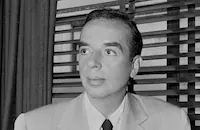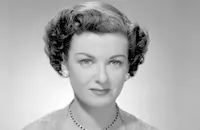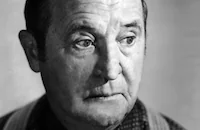Father of the Bride

Brief Synopsis
Cast & Crew
Vincente Minnelli
Spencer Tracy
Joan Bennett
Elizabeth Taylor
Don Taylor
Billie Burke
Film Details
Technical Specs

Synopsis
Following the wedding of his daughter Kay, Stanley T. Banks, a suburban lawyer, recalls the day, three months earlier, when he first learned of Kay's engagement to Buckley Dunstan: At the family dinner table, Kay's casual announcement that she is in love with Buckley and has accepted his proposal makes Stanley feel uneasy, but he soon comes to realize that his daughter has grown up and the wedding is inevitable. While Ellie, Kay's mother, immediately begins making preparations for the wedding, Stanley lies awake at night, fearing the worst for his daughter. Stanley's misgivings about the marriage eventually make Ellie anxious, and she insists that Kay introduce them to Buckley's parents. Kay calls the tradition "old-fashioned rigamarole," but arranges the meeting nevertheless. Before the introduction, Stanley has a private conversation with Buckley, and is pleased to learn that the young man is the head of a small company and that he is capable of providing a comfortable life for Kay. The Bankses' first meeting with Doris and Herbert, Buckley's parents, gets off to an awkward start, and goes from bad to worse when Stanley drinks too much and falls asleep in the wealthy Dunstans' living room. Following Kay and Buckley's engagement party, Stanley, who misses the entire party because he is in the kitchen mixing drinks, realizes that his plans for a small wedding have been swept aside and he will be expected to pay for an extravagant wedding "with all the trimmings." As costs for the June event spiral out of control, Stanley calculates that he can afford to accommodate no more than one hundred and fifty guests. The task of paring down the guest list proves too difficult, however, and Stanley reluctantly consents to a 250-person reception. The plans for a lavish wedding continue until the day that Buckley tells Kay that he wants to take her on a fishing trip in Nova Scotia for their honeymoon. Kay reacts to the announcement with shock and calls off the wedding, but she and Buckley soon reconcile, and the two families begin their wedding rehearsals. On the day of the wedding, chaos reigns at the Banks home as final preparations are made for the reception. The wedding ceremony brings both joy and sorrow to Stanley, as he realizes that his daughter is now a woman and no longer his child. The following day, Ellie and Stanley survey the mess in their home and concur that the entire affair was a great success.

Director

Vincente Minnelli
Cast

Spencer Tracy

Joan Bennett

Elizabeth Taylor

Don Taylor

Billie Burke

Leo G. Carroll

Moroni Olsen

Melville Cooper

Taylor Holmes

Paul Harvey

Frank Orth

Rusty Tamblyn
Tom Irish
Marietta Canty
Willard Waterman
Nancy Valentine
Mary Jane Smith
Jacqueline Duval
Fay Baker
Frank Hyers
Chris Drake
Floyd Taylor
Don Anderson
William Mahan
Walter Kelly

Peter Thompson

Carleton Carpenter
Lucille Barnes
Erin Selwyn
Janet Fay
Wendy Waldron

Douglas Spencer

Paul Maxey
William E. Green
Frank Cady
Ella Ethridge
Dorothy Phillips
Anne Kunde
William Bailey
Stuart Holmes
Fred Santley
Philo Mccullough
Harry Stanton
Lucille Curtis
Estelle Ettere
Peggy Leon
Betty Farrington

Lillian Bronson
Thomas Brown Henry
Mickey Golden
Gene Coogan

Lee Phelps

Patricia Miller
Frank Richards
William Haade
Jeff York
Dewey Robinson
Ed Gargan
Ralph Peters
Dick Wessell
Dick Alexander
Joe Brown Jr.
Jim Hayward
Gil Perkins
Brad Hutton
John Walsh
William "bill" Phillips
Boyd Davis
Oliver Blake

Roger Moore
Mickey Mccardle
Sherry Hall
Aileen Carlyle
Crew
John Alton
Pandro S. Berman
Jack Dawn
Adolph Deutsch
Cedric Gibbons
Keogh Gleason
Frances Goodrich
Sydney Guilaroff
Albert Hackett
Walter Plunkett
Helen Rose
Douglas Shearer
Marvin Stuart
Leonid Vasian
Ferris Webster
Edwin B. Willis

Photo Collections
Videos
Movie Clip






Trailer
Hosted Intro







Promo
Film Details
Technical Specs

Award Nominations
Best Actor
Best Picture
Best Writing, Screenplay
Articles
Father of the Bride (1950)
Studio head Dore Schary thought Edward Streeter's best-selling comic novel was a natural for the husband-and-wife team of Francis Goodrich and Albert Hackett, who had worked magic on such simple, all-American stories as It's a Wonderful Life and Easter Parade. But they took one look at the episodic novel and swore it was unadaptable. Schary was used to such reluctance on their part, and patiently led them through the first few weeks of the writing. Every time they swore they had failed, he showed them what worked in their scenes, until they came up with a screenplay that pleased everyone.
Goodrich and Hackett had shaped the father's role for Spencer Tracy, the only actor Minnelli thought capable of capturing the story's humor along with the heartache of a man giving up his beloved daughter. Then Jack Benny approached Schary at a party, and the studio head foolishly said he could do it. Minnelli had to test him for the part, but though he worked tirelessly to reduce Benny's trademarked double takes to a minimum, it was clear that the brilliant comic just didn't have the dramatic chops for the role.
Unfortunately, when Tracy heard that another actor had tested, he turned the picture down. Minnelli got Katharine Hepburn to arrange a dinner party where he convinced Tracy that they couldn't make the film without him. That was just the reassurance Tracy needed to change his mind.
The 17-year-old Elizabeth Taylor, MGM's top young actress at the time, was the only choice to play Tracy's daughter. And just to add to the film's publicity, when they announced her casting, Taylor announced her engagement to Conrad Hilton Jr. As she told the press, the thought of planning her own wedding and playing a young bride at the same time was "positively drooly."
When Taylor got married just a few weeks before the film's June 1950 release, it created a PR bonanza that helped make it one of the year's top-grossing pictures. Only it wasn't William Pawley who met her at the end of the aisle. By the time Taylor got around to making Father of the Bride, Pawley had tired of living around her schedule, and the engagement had ended. Instead, Taylor fell for hotel heir Nicky Hilton, who became her first husband on May 6, 1950.
The first rushes for Father of the Bride were so strong that MGM immediately registered the title Now I'm a Grandfather and negotiated sequel rights with Streeter. The sequel was made a year later, under the title Father's Little Dividend, and defied conventional wisdom by doing almost as well at the box office as the original. By the time of the second film, in which a happily married Taylor has her first child, Taylor's first marriage was over, a fact not trumpeted in the film's publicity.
Trivia: No company has been more involved in placing their product in Hollywood films than Coca-Cola. It started with Dinner at 8, which was promoted at hundreds of Coca-Cola outlets with posters that featured Jean Harlow and other cast members drinking the product during breaks in filming. In Father of the Bride, Spencer Tracy (who was used in print ads for Coca-Cola), offers guests at the engagement party Cokes to drink.
Director: Vincente Minnelli
Producer: Pandro Berman
Screenplay: Edward Streeter (novel), Frances Goodrich, Albert Hackett
Cinematography: John Alton
Art Direction: Cedric Gibbons, Leonid Vasian
Music: Adolph Deutsch
Cast: Spencer Tracy (Stanley Banks), Joan Bennett (Ellie Banks), Elizabeth Taylor (Kay Banks), Don Taylor (Buckley Dunstan), Billie Burke (Doris Dunstan), Leo G. Carroll (Mr. Massoula)
BW-93m. Closed captioning. Descriptive Video.
by Frank Miller

Father of the Bride (1950)
Quotes
Who giveth this woman? "This woman." But she's not a woman. She's still a child. And she's leaving us. What's it going to be like to come home and not find her? Not to hear her voice calling "Hi, Pops" as I come in? I suddenly realized what I was doing. I was giving up Kay. Something inside me began to hurt.- Stanley T. Banks
You fathers will understand. You have a little girl. She looks up to you. You're her oracle. You're her hero. And then the day comes when she gets her first permanent wave and goes to her first real party, and from that day on, you're in a constant state of panic.- Stanley T. Banks
Trivia
The premiere of this film took place two days after 'Taylor, Elizabeth' 's real-life marriage to Nicky Hilton. The publicity surrounding the event is credited with helping to make the film so successful.
Notes
A November 1948 Hollywood Reporter news item notes that M-G-M purchased the film rights to Edward Streeter's novel for $100,000 plus "other considerations," and that the sum was the highest price paid by the studio for a story property in that year. A January 1950 Daily Variety news item noted that Jack Benny was tested for the part played by Spencer Tracy. Tracy and Joan Bennett had earlier appeared together in the 1932 Fox Film Corp. picture Me and My Gal (see AFI Catalog of Feature Films 1930-41; F3.2790). Some of the film's story is told in voice-over narration by Tracy's character. The film's release coincided with the wedding of Elizabeth Taylor to Nicky Hilton, son of millionaire hotelier Conrad Hilton, an event that M-G-M exploited in its publicity campaign for the picture. Helen Rose, who designed Taylor's gown for the film, also designed the gown for her wedding to Nicky Hilton.
Father of the Bride was one of the top grossing films of 1950, and received the following Academy Award nominations: Best Picture, Best Screenplay and Best Actor (Spencer Tracy). In 1951, M-G-M released a sequel to the film, entitled Father's Little Dividend, in which Tracy, Taylor, Don Taylor, Billie Burke and Joan Bennett reprised their roles. Vincente Minnelli also directed the sequel. A 1991 remake of Father of the Bride was directed by Charles Shyer and starred Steve Martin and Diane Keaton. Father of the Bride was also produced as a short-lived television series from 1961 to 1962, featuring Ruth Warwick, Myrna Fahey and Leon Ames (in Tracy's role).
















